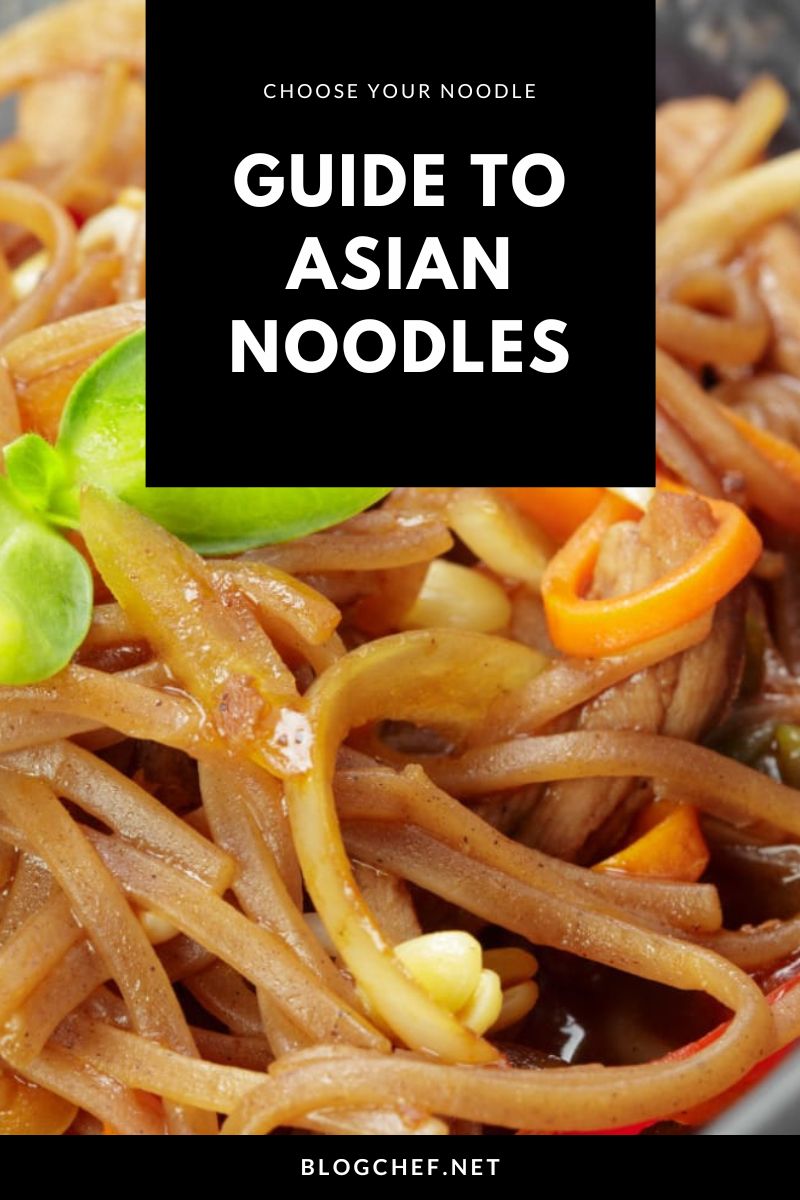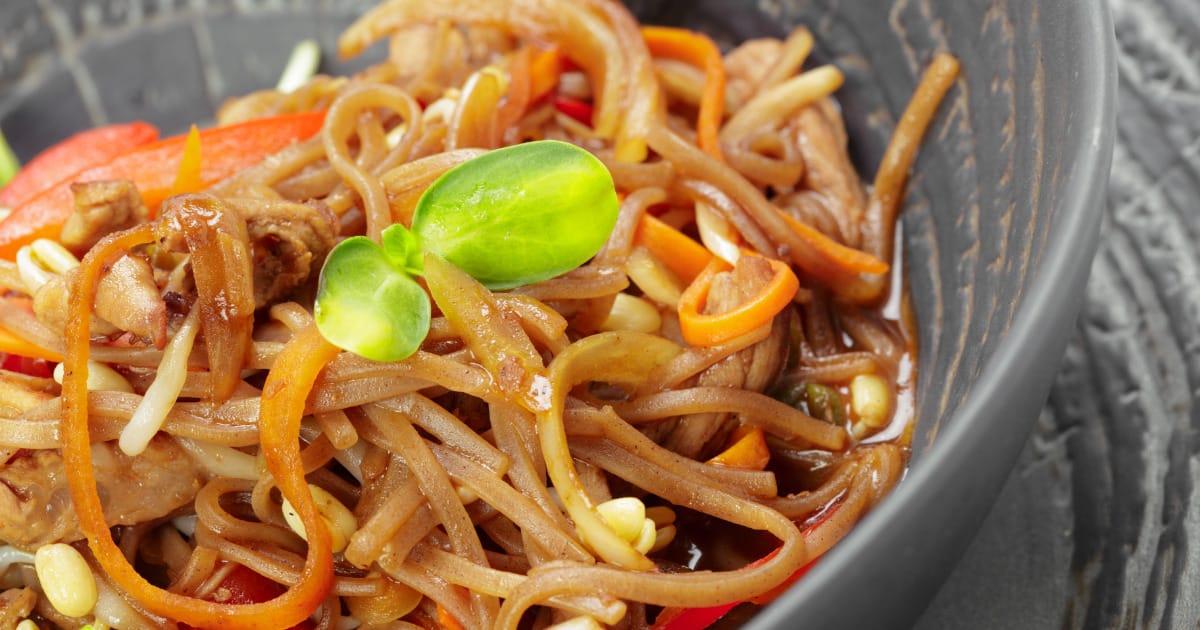Do you love a good noodle? Whether you’re in the mood for a slurp-worthy bowl of ramen or a piping hot plate of pad thai, this guide to the wonderful world of Asian noodles will give you the lowdown on the most common types, what ingredients they contain, and what dishes they’re best suited for.
When it comes to Asian noodles, there’s a whole universe of delicious strands to explore. From the satisfying chew of Japanese udon or the delicate, silky texture of Vietnamese glass noodles, you’ll find them in the noodle aisle of your favorite Asian market. This guide explores the most popular types of noodles, their unique characteristics, and the mouthwatering dishes made from them. So, put on your stretchy pants, grab a pair of chopsticks, and get ready to choose your noodle.

Ramen noodles
You can’t have a bowl of ramen without noodles. Ramen noodles are wheat noodles treated with an alkalinizing agent called “kansui” to give them their distinctive springy texture. They come in several forms: fresh, dried, or instant. You can find all types in an Asian market, a well-stocked supermarket, or online. Ramen noodles most often appear in soup, but they also work great in stir-fries, like yakisoba, and cold salads.
Udon noodles
If you’re in the mood for something hearty and satisfying, udon may be your noodle. These noodles, made from wheat, flour, and water, are thicker and chewier than most other noodles. You can enjoy them in a hot, savory broth or stir-fried with meat, veggies, and seasonings. You can buy them fresh, fresh-frozen, vacuum-packed, or dried.
Soba noodles
Soba noodles are a nutritious option as they use buckwheat flour, which despite the name, is wheat- and gluten-free. They are high in fiber and protein and have a nutty flavor and a slightly chewy texture. You can serve soba noodles hot in stir-fries or cold in salads.
I am a fan of soba, the buckwheat noodles popular in the Matsumoto region of Japan. I especially love the ritual of eating soba. Pour some soy sauce into the small bowl provided, use your chopsticks to dip the cold noodles into the sauce, and then slurp away. When you are done with your noodles, it’s time for soba-yu, the hot water used to boil the buckwheat soba noodles. Pour the hot soba-yu into the residue that you used to dip your soba and then drink it like a soup.
Jennifer Petoff, Sidewalk Safari
Somen noodles
Somen noodles are thin, slippery, white Japanese noodles made from wheat flour. They are popular as a cold dish in the summer months. Serve them with a dipping sauce, such as tsuyu, or with toppings like green onions, shiso leaves, and grated ginger.
Glass noodles
The name glass noodles covers a range of noodles from different cuisines. Also known as cellophane noodles, bean thread noodles, mung bean noodles, or “dangmyeon,” these transparent noodles are used in many Asian cuisines, including Chinese, Korean, and Thai.
Glass noodles are made from starches like mung bean starch, rice starch, potato starch, and sweet potato starch and come in bundles of thin, thread-like strands. To serve glass noodles, soak them in hot water to soften or cook them briefly in boiling water and then add them to soups, stir-fries, like Korean japchae, salads, like Thai yum woon sen, and spring rolls.
Korean sweet potato noodles, also known as “dangmyeon,” are a type of glass noodle made from sweet potato starch. They have a translucent, chewy texture and are common in Korean cuisine, particularly the dish japchae, a noodle stir-fry with vegetables and meat. Try them stir-fried with a spoonful of gochujang for a spicy kick.
Japchae are by FAR my favorite Asian noodles. They’re visually appealing, and they’re made from sweet potato starch, so they’re relatively healthy. On top of that, they’re very delicious.”
JD Alewine, Them Bites
Rice noodles
Rice noodles, rice stick noodles, or rice vermicelli are translucent noodles made from rice flour. They are common in many Southeast Asian cuisines, including Thai, Vietnamese, and Cambodian, and also appear in Cantonese and Malaysian cuisines. They are naturally gluten-free, making them a good choice for people with allergies.
I absolutely love the taste of steamed, flat rice noodles as part of vegetable pho in Vietnam. According to our cooking class chef, these type of noodles are perfect for absorbing seasoning, which is why they’re so popular.
Iain Salter, The Road Trip Expert
Pad Thai and pad see ew noodles are both rice noodles used in Thai recipes. Pad see ew noodles are broader and thicker than pad thai noodles.
Chow fun noodles are also made from rice flour. They are wide, flat, chewy noodles used in Cantonese dishes such as beef chow fun, a stir-fry with beef, bean sprouts, and scallions seasoned with dark soy sauce.
As someone who cooks gluten-free for my family, I love Asian noodles! There are so many great options for rice noodles that are super tasty.
Sharon McCaskill, The Helpful GF
Chow mein noodles
Chow mein noodles are Chinese egg noodles that are often stir-fried with vegetables and meat. They have a slightly chewy texture and are typically thicker than other Chinese noodles. Chow mein noodles come in both soft and crispy varieties.
Lo mein noodles
Lo mein noodles are another Chinese noodle made from wheat flour and eggs. They are thinner and softer than chow mein noodles and are delicious in soups or stir-fries. Lo mein works well with various vegetables and proteins, such as chicken, beef, or shrimp.
Hokkien noodles
Hokkien noodles are Chinese egg noodles that originated in the Fujian province of China. They have a thick, chewy texture and are usually put in soups and stir-fries with vegetables and meat. Hokkien noodles are often cooked with seafood, such as shrimp or squid, and are a popular ingredient in Singaporean and Malaysian cuisine.
Shirataki noodles
Shirataki noodles are low-calorie, low-carb Japanese noodles made from the root of the konjac yam. They have a gelatinous texture and can substitute for pasta or rice in low-carb or gluten-free diets. Shirataki noodles are commonly used in Japanese hot pot dishes and come in dry and pre-cooked forms.
The final word
Whether you’re in the mood for a hearty soup, a light salad, or a spicy stir-fry, there’s an Asian noodle that’s perfect for the job. And the best part? These noodles are all incredibly versatile and easy to prepare, making them a great addition to any home cook’s repertoire. So, the next time you’re feeling uninspired in the kitchen, mix things up with a bowl of ramen or a plate of pad thai. Your taste buds, and your dinner guests, will thank you.
This post first appeared on Food Drink Life.
